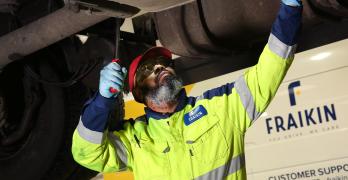Driver-facing cameras: A roadmap to enhanced fleet safety
- 23/10/24
- 3 min
As technology advances, driver-facing cameras have emerged as a powerful tool in the pursuit of safer roads. However, implementing such systems requires careful planning and consideration to ensure success for both operators and drivers alike.

The safety imperative
Leading road safety organisations, such as Brake, the road safety charity, and the The Royal Society for the Prevention of Accidents (RoSPA), have long highlighted the dangers of driver distraction. From mobile phone use, fatigue, eating and drinking, or passenger interactions, a driver taking their eyes off the road for even a moment can lead to serious consequences. Add to this the persistent issue of seatbelt compliance, and it is clear why fleet operators are increasingly turning to driver-facing camera technology as part of their safety strategy.
While traditional telematics have granted insights into harsh braking, acceleration and speeding, the addition of AI-powered external cameras has expanded the understanding of road risk to include tailgating and improper lane use. Now, driver-facing cameras are set to take safety monitoring to the next level – but their implementation must be handled with care and consideration.
For fleet operators considering the rollout of driver-facing cameras, a clear and well-communicated strategy is essential:
- Stakeholder consultation – Before cameras are installed, engage with all relevant parties, from unions and drivers to legal and insurance professionals. These stakeholders need to understand the purpose and processes behind the technology, helping to prevent potential resistance or concerns down the line.
- Address privacy head-on – Privacy is often the first concern raised by drivers. It's crucial to explain that these systems do not provide real-time surveillance. Instead, they only capture and send footage when triggered by specific events. This aligns with GDPR requirements and can actually benefit drivers by providing evidence to counter fraudulent claims.
- Policy updates – Clear company policies should outline what behaviours will be monitored and what consequences may follow specific safety breaches.
Any successful safety programme will balance accountability with recognition. As such, it is also certainly worth considering implementing a rewards system for drivers who demonstrate consistent safe driving practices. This could include:
- Monthly perks such as coffee vouchers or online shopping credits.
- Annual ceremonies celebrating top performers.
- Team-based incentives to foster a collective safety culture.
Gradual rollout
Rather than an immediate fleet-wide implementation, a phased approach is recommended. Start by installing cameras in a subset of vehicles, allowing you to identify and resolve any technical issues before a broader rollout.
Once cameras are online, focus on critical safety breaches, such as excessive speeding, while gradually adjusting settings as driver behaviour improves. Implementing auditory warnings or ‘nudges’ can help drivers adapt to the new system, providing real-time feedback without being overly punitive during the adjustment period.
In addition, a safety policy should not be set in stone and regular reviews – ideally every three months – are essential for long-term success. These reviews enable fleet managers to focus on specific behaviours as they emerge and tailor training programmes accordingly.
By varying approaches and focusing on different settings over time, you can prevent 'coaching fatigue' and keep drivers engaged with the programme. This adaptive approach also ensures that new joiners receive appropriate support as they acclimatise to your business’ expected safety standards.
Looking to the future
As our roads become increasingly busy, the role of technology in ensuring safety will only grow. Driver-facing cameras represent not just a monitoring tool, but an opportunity to create a more conscientious, safety-focused driving culture.
At Fraikin, we understand the challenges fleet operators face when attempting to seamlessly implement any new safety measures – with that in mind, our expert teams are here to guide you through the process, ensuring your rollout enhances safety while maintaining driver satisfaction and operational efficiency.
Whether you're considering implementing driver-facing cameras or looking to optimise your existing safety systems, talk to Fraikin about how we can help you prioritise safety across your fleet.
Also worth reading

Labour’s Autumn Budget Uncertainty Highlights the Value of Contract Hire

Driver walkaround checks: Why they matter and how Fraikin is making them easier

